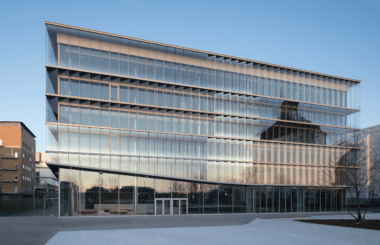List of Guiding Principle Articles
- Prelude: What Organizations Have in Common With Living Systems
- Principle #1: Radical Openness
- Principle #2: Sensing the Core
- Principle #3: Identifying and Bringing to Life Latent Potentials
- Principle #4: Designing and Co-creating
- Principle #5: Emergence
- Principle #6: Enabling
- Principle #7: Learning from the Future as it Emerges
This article is one of a series of blog posts in which we, the theLivingCore, present our fundamental guiding principles. We already introduced the scientific groundwork of our approach and the first of our seven principles – the principle of radical openness. And as you might guess, this time we’re going to share our second principle. theLivingCore’s second principle represents how we look at organizations or objects of innovation – how we perceive them, how we sense them, or how we get to know their “inner workings”. Thereby, the question is why things exist in the first place, be it an organization, its environment, a process, or an object of innovation. The second principle represents that our work always aims at sensing the very core of an object we’re interested in. Let us take a look at what we mean by that.
Why are things the way they are?
When we go about our everyday life, we usually do not ask ourselves why we do what we do – and why things are the way they are. When being asked what our organization, company, products, and services are all about and which end they serve, we can swiftly answer. We might answer, “we’re building cars and cars exist to take us from A to B”, or “we produce chairs so that people can sit on them”. At first glance, these questions seem rather easy and trivial. We seem to be familiar with the reason why things turned out a certain way.
That might be the whole story about our day-to-day activities. Yet, our answers can be easily exposed as lacking depth and foresight – and that they’re incomplete. How can we be so sure? Because we often lack the right answer if we rephrase the question. We especially see this when we start wondering about the future.
Indeed, it is a whole different story when we ask ourselves these questions while having the future in mind. How can our organization look in 10 years? Which products and services will we develop and offer? What kind of business model will we deploy – and in what kind of market? These questions are way more difficult to answer. They reveal that it is actually quite difficult to expose the reason behind why things are what they are.
Sensing the core: gaining a deep understanding
To explain: the reason for the existence of our organizations and products/services is visible “on the surface”. But there is more to learn – and more to see if we go deeper. But what exactly are we looking for here?
For example, a car of a certain brand is not just a car to go from A to B but way more than that. The same goes for a chair, which is often not only an object to sit upon. It involves a certain design, tells a story, and is full of meaning. All such things (and often there is plenty of them) are, in sum, essential to understanding the core of an object. And in this case, the whole is more than the sum of its parts.
All in all, there are two things that we must be able to “sense”:
- We must achieve a profound understanding of the core (of an organization, product, service).
- We have to identify and develop future potentials (of an organization, product, service).
Put simply, we first need to have a deep understanding of what we are interested in. Only then can we make sense of the organization’s or product’s/service’s future. Most interestingly, (1) and (2) are deeply intertwined. By understanding future potentials, we understand the very core or essence of an organization or product/service. And by understanding their core, we gain access to their future potentials.
But how do we achieve this? How can we sense and understand the core of some object of interest?
Asking the right questions
One approach we consider powerful is to draw on the idea of Aristotle’s causes. The Greek philosopher distinguished between ways of asking the “why”-question. To really know the reason behind why things are the way they are, one must learn four things.
- Causa finalis: What is its goal? What is its purpose?
- Causa formalis: What is it?
- Causa efficiencs: Where does it come from?
- Causa functionalis: How does it function?
- Causa materialis: What is it made of?
These questions might sound rather trivial. But don’t be deceived. By asking them, again and again (almost like a child relentlessly asking why things are the way they are), one continually deepens one’s understanding and gets ever closer to the core of what one seeks to understand.
Again, even though this might sound simple, it is a highly challenging task to be asking questions in such a manner. No one can do so offhandedly. It requires openness and a high degree of perceptiveness. Last but not least, it requires patience.
A case study
For those of you who consider this too abstract, let us provide you with an example. In the late nineties, the design firm IDEO was commissioned with the task of “reinventing” the shopping cart. What they came up with was – you won’t be surprised – a shopping cart, albeit a very sophisticated one, with several new functions, removable baskets, etc.
What is striking, however, is that the designer did not go as far as asking the “why” questions. They didn’t try to understand the very core of the object of innovation. Even though they did their research first, they especially avoided the “causa finalis” question. And they certainly did not seek out what we called the “core”. That is not to say that their product was bad. It is just to say that once we understand the “true nature”, or the core of things like the shopping cart, we might not end up with a sophisticated shopping cart after all. Rather, we might end up inventing a totally different and novel product or service. And that one can only do by gaining a deep understanding of an object’s purpose.
The reason for this is that asking “why” questions does not simply expose why shopping carts exist. Rather, it challenges the very idea of the shopping cart. We might as well ask: looking at its purpose, will we actually still need the shopping cart in the future? That is to say, if we focus on the purpose of the object in question (rather than simply focusing on the object), we open up a whole new playing field. We see potentials that go way beyond the original object of interest.
If all this is the basis of an innovation process, then truly novel ideas can emerge, ranging from radically new products, services, and even business models. So maybe back in the nineties, this would have led IDEO not to develop fancy shopping carts. Maybe they would have come up with entirely novel ways of shopping such as delivery services or grocery orders.
Suffice it to say that IDEO’s shopping cart didn’t age well. All around the globe, the traditional shopping cart prevailed. This reflects another insight that should be highlighted here: Not taking the time to explore the core of an object at the beginning of a deep innovation process often results in (1) “more of the same” or (2) yields “workshop insights” that won’t last. In other words, if you aim to develop novel products and services, you risk producing something more or less random.
Hence, radical innovation cannot just rely on our perception of the “surface” of an object of innovation. It has to go deeper. To explore its “core” is thus to go beyond what is superficially visible. It is to take indeed a philosophical and empathic approach. Doing so will help us to get to know the object of innovation “from within” rather than “from the outside”. This is also why listening to users/customers, while highly important, is also only part of the solution. Findings gained this way must also be related to the core of the object of innovation. In other words, a deep and future-oriented understanding of the core of a product/service shapes the innovation, while user feedback rather modulates it.
To conclude, our second principle is a crucial part of our way of working and a key component of our innovation technology “leap“. Our experience has always shown: radical innovation demands that we first understand the very essence of the object of innovation – that we “sense its core”.
Author: Oliver Lukitsch
Image: June Wong at Unsplash
Subscribe to Our Newsletter
Keep your innovative edge with more stories like this and additional reading tips, muses, and project updates.


